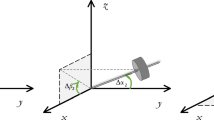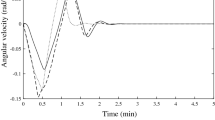Abstract
A new approach for feedback linearization of attitude dynamics for rigid gas jet-actuated spacecraft control is introduced. The approach is aimed at providing global feedback linearization of the spacecraft dynamics while realizing a prescribed linear attitude deviation dynamics. The methodology is based on nonuniqueness representation of underdetermined linear algebraic equations solution via nullspace parametrization using generalized inversion. The procedure is to prespecify a stable second-order linear time-invariant differential equation in a norm measure of the spacecraft attitude variables deviations from their desired values. The evaluation of this equation along the trajectories defined by the spacecraft equations of motion yields a linear relation in the control variables. These control variables can be solved by utilizing the Moore–Penrose generalized inverse of the involved controls coefficient row vector. The resulting control law consists of auxiliary and particular parts, residing in the nullspace of the controls coefficient and the range space of its generalized inverse, respectively. The free null-control vector in the auxiliary part is projected onto the controls coefficient nullspace by a nullprojection matrix, and is designed to yield exponentially stable spacecraft internal dynamics, and singularly perturbed feedback linearization of the spacecraft attitude dynamics. The feedback control design utilizes the concept of damped generalized inverse to limit the growth of the Moore–Penrose generalized inverse, in addition to the concepts of singularly perturbed controls coefficient nullprojection and damped controls coefficient nullprojection to disencumber the nullprojection matrix from its rank deficiency, and to enhance the closed loop control system performance. The methodology yields desired linear attitude deviation dynamics realization with globally uniformly ultimately bounded trajectory tracking errors, and reveals a tradeoff between trajectory tracking accuracy and damped generalized inverse stability. The paper bridges a gap between the nonlinear control problem applied to spacecraft dynamics and some of the basic generalized inversion-related analytical dynamics principles.
Similar content being viewed by others
References
Meyer, G.: On the use of Euler’s theorem on rotations for the synthesis of attitude control systems. NASA TN D-3643 (1966)
Meyer, G.: Design and global analysis of spacecraft attitude control systems. NASA TRR-361 (1971)
Hunt, L.R., Su, R., Meyer, G.: Global transformations of nonlinear systems. IEEE Trans. Autom. Control 28, 24–31 (1983)
Dwyer, T., III: Exact nonlinear control of large angle rotational maneuvers. IEEE Trans. Autom. Control 29(9), 769–774 (1984)
Paielli, R.A., Bach, R.E.: Attitude control with realization of linear error dynamics. J. Guid. Control Dyn. 16(1), 182–189 (1993)
Schaub, H., Akella, M.R., Junkins, J.L.: Adaptive control of nonlinear attitude motions realizing linear closed loop dynamics. J. Guid. Control Dyn. 24(1), 95–100 (2001)
Shuster, M.D.: A survey of attitude representation. J. Astronaut. Sci. 41(4), 439–517 (1993)
Moore, E.H.: On the reciprocal of the general algebraic matrix. Bull. Am. Math. Soc. 26, 394–395 (1920)
Penrose, R.: A generalized inverse for matrices. Proc. Camb. Philos. Soc. 51, 406–413 (1955)
Greville, T.N.E.: The pseudoinverse of a rectangular or singular matrix and its applications to the solutions of systems of linear equations. SIAM Rev. 1(1), 38–43 (1959)
Udwadia, F.E., Kalaba, R.E.: Analytical Dynamics, A New Approach. Cambridge University Press, New York (1996)
Gauss, C.F.: Ueber ein neues algemeines Grundgesetz der Mechanik. Z. Reine Angew. Math. 4, 232–235 (1829)
Goldstein, H., Poole, C., Safco, J.: Classical Mechanics, 3rd edn. Addison-Wesley, San Francisco (2002)
Udwadia, F.E.: A new perspective on the tracking control of nonlinear structural and mechanical systems. Proc. R. Soc. Lond. Ser. A 459, 1783–1800 (2003)
Bruyninckx, H., Khatib, O.: Gauss’ principle and the dynamics of redundant and constrained manipulators. In: IEEE International Conference on Robotics & Automation, San Francisco, CA (2000)
De Sapio, V., Khatib, O., Delp, S.: Task-level approaches for the control of constrained multibody systems. Multibody Syst. Dyn. 16, 73–102 (2006)
Bajodah, A.H., Hodges, D.H., Chen, Y.-H.: Inverse dynamics of servo-constraints based on the generalized inverse. Nonlinear Dyn. 39(1–2), 179–196 (2005)
Liegeois, A.: Automatic supervisory control of the configuration and behavior of multi-body mechanisms. IEEE Trans. Syst. Man Cybern. 7(12), 868–871 (1977)
Mayorga, R.V., Janabi-Sharifi, F., Wong, A.K.C.: A fast approach for the robust trajectory planning of redundant robot manipulators. J. Robot. Syst. 12(2), 147–161 (1995)
Yoon, H., Tsiotras, P.: Singularity analysis of variable-speed control moment gyros. J. Guid. Control Dyn. 27(3), 374–386 (2004)
Nakamura, Y., Hanafusa, H.: Inverse kinematic solutions with singularity robustness for robot manipulator control. J. Dyn. Syst. Meas. Control 10(8), 163–171 (1986)
Wampler, C.W., II: Manipulator inverse kinematic solutions based on vector formulations and damped least-squares methods. IEEE Trans. Syst. Man Cybern. 16, 93–101 (1986)
Oh, H.S., Vadali, S.R.: Feedback control and steering laws for spacecraft using single gimbal control moment gyros. J. Astronaut. Sci. 39(2), 183–203 (1991)
Sastry, S.: Nonlinear Systems: Analysis, Stability, and Control. Springer, New York (1999)
Bernstein, D.: Matrix Mathematics: Theory, Facts, and Formulas with Application to Linear System Theory. Princeton University Press, Princeton (2005)
Khalil, H.K.: Nonlinear Systems, 3rd edn. Prentice-Hall, New York (2002)
Tsiotras, P.: A passivity approach to attitude stabilization using nonredundant sets of kinematic parameters. In: Proceedings of the 34th Conference on Decision and Control, New Orleans, LA, pp. 515–520 (1995)
Baker, D.R., Wampler, C.W., II: On inverse kinematics of redundant manipulators. Int. J. Robot. Res. 7(2), 3–21 (1988)
Peterson, K.B., Pederson, M.S.: The Matrix Cookbook, E-manual. Technical University of Denmark, February (2006)
Bedrossian, N.S.: Steering law design for redundant single gimbal control moment gyro systems. MS thesis, Mechanical Engineering, Massachusetts Institute of Technology, Cambridge, MA, August (1987)
Author information
Authors and Affiliations
Corresponding author
Rights and permissions
About this article
Cite this article
Bajodah, A.H. Singularly perturbed feedback linearization with linear attitude deviation dynamics realization. Nonlinear Dyn 53, 321–343 (2008). https://doi.org/10.1007/s11071-007-9316-0
Received:
Accepted:
Published:
Issue Date:
DOI: https://doi.org/10.1007/s11071-007-9316-0
Keywords
- Spacecraft attitude control
- Singularly perturbed feedback linearization
- Linear attitude deviation dynamics realization
- Control authority redundancy
- Nullspace parametrization
- Controls coefficient
- Moore–Penrose generalized inverse
- Damped generalized inverse
- Singularly perturbed nullprojection
- Damped nullprojection
- Null-control vector




